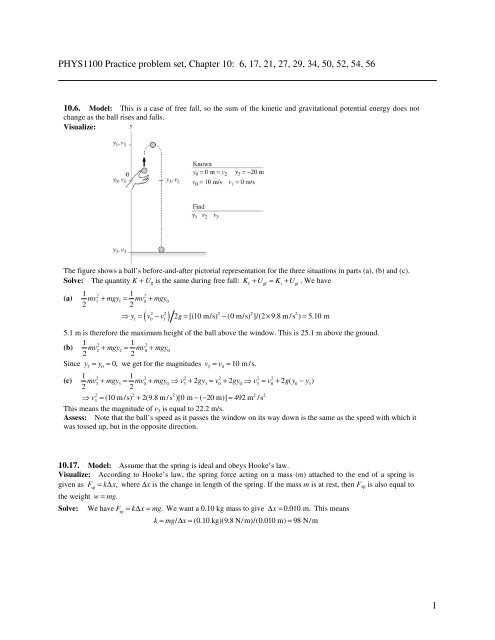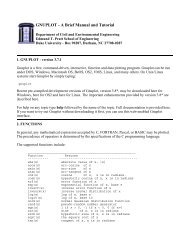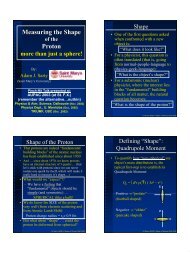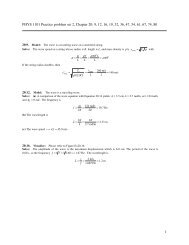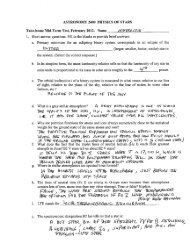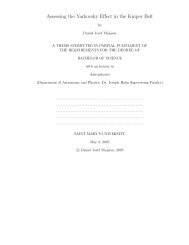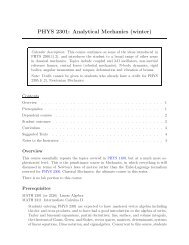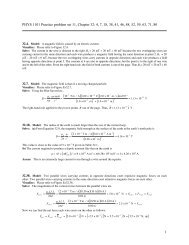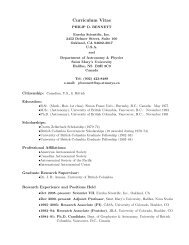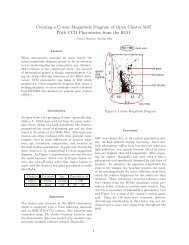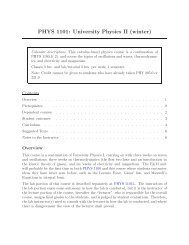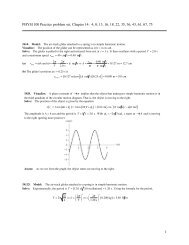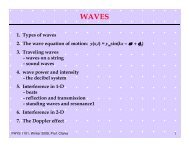1 PHYS1100 Practice problem set, Chapter 10: 6, 17, 21, 27, 29, 34 ...
1 PHYS1100 Practice problem set, Chapter 10: 6, 17, 21, 27, 29, 34 ...
1 PHYS1100 Practice problem set, Chapter 10: 6, 17, 21, 27, 29, 34 ...
You also want an ePaper? Increase the reach of your titles
YUMPU automatically turns print PDFs into web optimized ePapers that Google loves.
<strong>PHYS1<strong>10</strong>0</strong> <strong>Practice</strong> <strong>problem</strong> <strong>set</strong>, <strong>Chapter</strong> <strong>10</strong>: 6, <strong>17</strong>, <strong>21</strong>, <strong>27</strong>, <strong>29</strong>, <strong>34</strong>, 50, 52, 54, 56<br />
<strong>10</strong>.6. Model: This is a case of free fall, so the sum of the kinetic and gravitational potential energy does not<br />
change as the ball rises and falls.<br />
Visualize:<br />
The figure shows a ball’s before-and-after pictorial representation for the three situations in parts (a), (b) and (c).<br />
Solve: The quantity K + U g is the same during free fall: Kf + Ugf = Ki + Ugi<br />
. We have<br />
(a)<br />
1 1<br />
mv + mgy = mv + mgy<br />
2 2<br />
2 2<br />
1 1 0 0<br />
( )<br />
⇒ y = v − v 2 g = [(<strong>10</strong> m/s) − (0 m/s) ]/(2× 9.8 m /s ) = 5.<strong>10</strong> m<br />
2 2 2 2 2<br />
1 0 1<br />
5.1 m is therefore the maximum height of the ball above the window. This is 25.1 m above the ground.<br />
2 2<br />
(b)<br />
1 mv2 + mgy 1<br />
2<br />
= mv0 + mgy0<br />
2 2<br />
Since y2 = y0 = 0, we get for the magnitudes v2 = v0 = <strong>10</strong> m /s.<br />
2 2 2 2 2 2<br />
(c)<br />
1 mv3 + mgy3 = 1 mv0 + mgy0 ⇒ v3 + 2gy3 = v0 + 2gy0 ⇒ v3 = v0 + 2 g( y0 − y3)<br />
2 2<br />
2 2 2 2 2<br />
⇒ v 3<br />
= (<strong>10</strong> m /s) + 2(9.8 m /s )[0 m − ( − 20 m)] = 492 m /s<br />
This means the magnitude of v 3 is equal to 22.2 m/s.<br />
Assess: Note that the ball’s speed as it passes the window on its way down is the same as the speed with which it<br />
was tossed up, but in the opposite direction.<br />
<strong>10</strong>.<strong>17</strong>. Model: Assume that the spring is ideal and obeys Hooke’s law.<br />
Visualize: According to Hooke’s law, the spring force acting on a mass (m) attached to the end of a spring is<br />
given as Fsp = k∆ x,<br />
where ∆x is the change in length of the spring. If the mass m is at rest, then F sp is also equal to<br />
the weight w = mg.<br />
Solve:<br />
We have F = k∆ x = mg.<br />
We want a 0.<strong>10</strong> kg mass to give ∆ x = 0.0<strong>10</strong> m. This means<br />
sp<br />
k = mg/ ∆ x = (0.<strong>10</strong> kg)(9.8 N/m)/(0.0<strong>10</strong> m) = 98 N/m<br />
1
<strong>10</strong>.<strong>21</strong>. Model: Assume an ideal spring that obeys Hooke’s law. There is no friction, so the mechanical energy<br />
K + U s is conserved. Also model the book as a particle.<br />
Visualize:<br />
The figure shows a before-and-after pictorial representation. The compressed spring will push on the book until the<br />
spring has returned to its equilibrium length. We put the origin of our coordinate system at the equilibrium position<br />
of the free end of the spring. The energy bar chart shows that the potential energy of the compressed spring is<br />
entirely transformed into the kinetic energy of the book.<br />
Solve: The conservation of energy equation K2 + Us2 = K1 + Us1<br />
is<br />
Using x 2 = x e = 0 m and v 1 = 0 m/s, this simplifies to<br />
1 mv + 1 k( x − x ) = 1 mv + 1 k( x − x )<br />
2 2 2 2<br />
2 2 2 2<br />
2 2 e 1 1 e<br />
2 2<br />
1 2 1 2 kx1<br />
(1250 N/m)(0.040 m)<br />
mv2 = k( x1 − 0 m) ⇒ v2<br />
= = = 2.00 m/s<br />
2 2 m (0.500 kg)<br />
Assess: This <strong>problem</strong> cannot be solved using constant-acceleration kinematic equations. The acceleration is not a<br />
constant in this <strong>problem</strong>, since the spring force, given as Fs = −k∆ x,<br />
is directly proportional to ∆x or | x − xe|.<br />
2
<strong>10</strong>.<strong>27</strong>. Model: In this case of a one-dimensional collision, the momentum conservation law is obeyed whether<br />
the collision is perfectly elastic or perfectly inelastic.<br />
Visualize:<br />
Solve: In the case of a perfectly elastic collision, the two velocities ( vf x) 1<br />
and ( v<br />
fx<br />
)<br />
2<br />
can be determined by combining<br />
the conservation equations of momentum and mechanical energy. By contrast, a perfectly inelastic collision involves<br />
only one final velocity v fx and can be determined from just the momentum conservation equation.<br />
Momentum conservation: m ( v ) + m ( v ) = m ( v ) + m ( v )<br />
(a)<br />
1 ix 1 2 ix 2 1 fx 1 2 fx<br />
2<br />
1 1 1 1<br />
Energy conservation: m ( v ) + m ( v ) = m ( v ) + m ( v )<br />
2 2 2 2<br />
2 2 2 2<br />
1 ix 1 2 ix 2 1 fx 1 2 fx<br />
2<br />
These two equations can be solved as shown in Equations <strong>10</strong>.39 through <strong>10</strong>.43:<br />
m − m (<strong>10</strong>0 g) − (300 g)<br />
( v ) = ( v ) = (<strong>10</strong> m/s) = −5.0 m/s<br />
+ (<strong>10</strong>0 g) + (300 g)<br />
1 2<br />
fx<br />
1 ix<br />
1<br />
m1 m2<br />
2m<br />
2(<strong>10</strong>0 g)<br />
( v ) = ( v ) = (<strong>10</strong> m/s) = + 5.0 m/s<br />
+ (<strong>10</strong>0 g) + (300 g)<br />
1<br />
fx<br />
2 ix<br />
1<br />
m1 m2<br />
(b) For the inelastic collision, both balls travel with the same final speed v . f x<br />
The momentum conservation<br />
equation p f<br />
= p i<br />
is<br />
x<br />
x<br />
( m + m ) v = m ( v ) + m ( v )<br />
1 2 fx 1 ix 1 2 ix<br />
2<br />
⎛ <strong>10</strong>0 g ⎞<br />
⇒ vf<br />
x<br />
= ⎜<br />
⎟(<strong>10</strong> m/s) + 0 m/s = 2.5 m/s<br />
⎝ <strong>10</strong>0 g + 300 g ⎠<br />
Assess: In the case of the perfectly elastic collision, the two balls bounce off each other with a speed of 5.0 m/s.<br />
In the case of the perfectly inelastic collision, the balls stick together and move together at 2.5 m/s.<br />
3
<strong>10</strong>.<strong>29</strong>. Model: For an energy diagram, the sum of the kinetic and potential energy is a constant.<br />
Visualize:<br />
The particle is released from rest at x = 1.0 m. That is, K = 0 at x = 1.0 m. Since the total energy is given by E = K + U,<br />
we can draw a horizontal total energy (TE) line through the point of intersection of the potential energy curve (PE)<br />
and the x = 1.0 m line. The distance from the PE curve to the TE line is the particle’s kinetic energy. These values<br />
are transformed as the position changes, causing the particle to speed up or slow down, but the sum K + U does not<br />
change.<br />
Solve: (a) We have E = 5.0 J and this energy is a constant. For x < 1.0, U > 5.0 J and, therefore, K must be<br />
negative to keep E the same (note that K = E − U or K = 5.0 J − U). Since negative kinetic energy is unphysical, the<br />
particle can not move to the left. That is, the particle will move to the right of x = 1.0 m.<br />
(b) The expression for the kinetic energy is E − U. This means the particle has maximum speed or maximum<br />
kinetic energy when U is minimum. This happens at x = 2.0 m. Thus,<br />
1 2<br />
2(4.0 J) 8.0 J<br />
Kmax = E − Umin = (5.0 J) − (1.0 J) = 4.0 J mvmax = 4.0 J ⇒ vmax<br />
= = = 20 m/s<br />
2 m 0.020 kg<br />
The particle possesses this speed at x = 2.0 m.<br />
(c) The total energy (TE) line intersects the potential energy (PE) curve at x = 1.0 m and x = 6.0 m. These are the<br />
turning points of the motion.<br />
4
<strong>10</strong>.<strong>34</strong>. Model: This is case of free-fall, so the sum of the kinetic and gravitational potential energy does not<br />
change as the cannon ball falls.<br />
Visualize:<br />
The figure shows a before-and-after pictorial representation. To express the gravitational potential energy, we put<br />
the origin of our coordinate system on the ground below the fortress.<br />
Solve: Using y f = 0 and the equation Ki + Ugi = Kf + Ugf<br />
we get<br />
1 1<br />
mv + mgy = mv + mgy ⇒ v + 2gy = v<br />
2 2<br />
2 2 2 2<br />
i i f f i i f<br />
v = v + 2 gy = (80 m/s) + 2(9.8 m/s )(<strong>10</strong> m) = 81.2 m/s<br />
2 2 2<br />
f i i<br />
Assess: Note that we did not need to use the tilt angle of the cannon, because kinetic energy is a scalar. Also note<br />
that using the energy conservation equation, we can find only the magnitude of the final velocity, not the direction<br />
of the velocity vector.<br />
5
<strong>10</strong>.50. Model: Since there is no friction, the sum of the kinetic and gravitational potential energy does not<br />
change. Model Julie as a particle.<br />
Visualize:<br />
We place the coordinate system at the bottom of the ramp directly below Julie’s starting position. From geometry,<br />
Julie launches off the end of the ramp at a 30º angle.<br />
2 2<br />
Solve: Energy conservation: K1 + Ug1 = K0 + Ug0<br />
⇒ 1 mv1 + mgy 1<br />
1<br />
= mv0 + mgy0<br />
2 2<br />
Using v0 = 0 m/s, y0 = 25 m, and y1<br />
= 3 m, the above equation simplifies to<br />
1 2 2<br />
mv1 mgy1 mgy0 v1 2 g( y0 y1<br />
) 2(9.8 m/s )(25 m 3 m) 20.77 m/s<br />
2 + = ⇒ = − = − =<br />
We can now use kinematic equations to find the touchdown point from the base of the ramp. First we’ll consider<br />
the vertical motion:<br />
y = y + v ( t<br />
1 1<br />
− t ) + a ( t − t ) 0 m = 3 m + ( v sin30 ° )( t − t ) + ( −9.8 m /s )( t<br />
2 2<br />
− t )<br />
2 (20.77 m/s)sin30 ° (3 m)<br />
( t2 − t1) − ( t<br />
2 2<br />
− t1) − = 0<br />
2<br />
(4.9 m/s ) (4.9 m/s )<br />
For the horizontal motion:<br />
2 2 2<br />
2 1 1y<br />
2 1 y 2 1 1 2 1 2 1<br />
( t − t ) − (2.119 s)( t − t ) − (0.6122 s ) = 0 ⇒ ( t − t ) = 2.377 s<br />
2 2<br />
2 1 2 1 2 1<br />
2 1 1 2 1<br />
1<br />
x = x + v ( t − t ) + a ( t − t )<br />
2<br />
2<br />
2 1 1x<br />
2 1 x 2 1<br />
x − x = ( v cos30 ° )( t − t ) + 0 m = (20.77 m/s)(cos30 ° )(2.377 s) = 42.7 m<br />
Assess: Note that we did not have to make use of the information about the circular arc at the bottom that carries<br />
Julie through a 90° turn.<br />
6
<strong>10</strong>.52. Model: Assume an ideal spring that obeys Hooke’s law. We treat the bullet and the block in the particle<br />
model. For a perfectly inelastic collision, the momentum is conserved. Furthermore, since there is no friction, the<br />
mechanical energy of the system (bullet + block + spring) is conserved.<br />
Visualize:<br />
We place the origin of our coordinate system at the end of the spring that is not anchored to the wall.<br />
Solve: (a) Momentum conservation for perfectly inelastic collision states p f<br />
= p i<br />
. This means<br />
⎛ m ⎞<br />
( m + M) v = m( v ) + M( v ) ⇒ ( m + M) v = mv + 0 kg m/s ⇒ v = ⎜ v<br />
m + M ⎟<br />
⎝ ⎠<br />
f i m i M f B f B<br />
where we have used v B for the initial speed of the bullet. The mechanical energy conservation equation K1 + Us1<br />
=<br />
K<br />
e<br />
+ U as the bullet embedded block compresses the spring is:<br />
se<br />
1 1 1 1<br />
m( v′ f<br />
) + k( x − x ) = ( m + M)( v ) + k( x − x )<br />
2 2 2 2<br />
2 2 2 2<br />
1 e f e e<br />
2<br />
2 ⎛ m ⎞ 2<br />
2<br />
m + M kd<br />
B B 2<br />
1 1 ( )<br />
0 J + kd = ( m + M) v 0 J v<br />
2 2<br />
⎜ + ⇒ =<br />
m M<br />
⎟<br />
⎝ + ⎠<br />
m<br />
(b) Using the above formula with m = 5.0 g, M = 2.0 kg, k = 50 N/m, and d = <strong>10</strong> cm,<br />
(c) The fraction of energy lost is<br />
2 2<br />
v<br />
B<br />
= (0.005 kg + 2.0 kg)(50 N/m)(0.<strong>10</strong> m) /(0.005) = 200 m/s<br />
1 2 1 2 2<br />
mv 2<br />
B<br />
− ( m + M ) vf<br />
2 2 m+<br />
M ⎛ v ⎞<br />
f<br />
m + M ⎛ m ⎞<br />
= 1− 1<br />
1<br />
⎜ ⎟ = −<br />
2<br />
mv<br />
m vB<br />
m<br />
⎜<br />
m M<br />
⎟<br />
⎝ ⎠<br />
⎝ + ⎠<br />
B<br />
2<br />
m<br />
0.005 kg<br />
= 1− = 1− = 0.9975<br />
m + M (0.005 kg + 2.0 kg)<br />
That is, during the perfectly inelastic collision 99.75% of the bullet’s energy is lost. The energy is dissipated inside<br />
the block. Although it is common to say, “The energy is lost to heat,” in the next chapter we’ll see that it is more<br />
accurate to say, “The energy is transformed to thermal energy.”<br />
7
<strong>10</strong>.54. Model: This is a two-part <strong>problem</strong>. In the first part, we will find the critical velocity for the ball to go<br />
over the top of the peg without the string going slack. Using the energy conservation equation, we will then obtain<br />
the gravitational potential energy that gets transformed into the critical kinetic energy of the ball, thus determining<br />
the angle θ.<br />
Visualize:<br />
We place the origin of our coordinate system on the peg. This choice will provide a reference to measure gravitational<br />
potential energy. For θ to be minimum, the ball will just go over the top of the peg.<br />
Solve: The two forces in the free-body force diagram provide the centripetal acceleration at the top of the circle.<br />
Newton’s second law at this point is<br />
2<br />
mv<br />
w + T =<br />
r<br />
where T is the tension in the string. The critical speed v c at which the string goes slack is found when T → 0. In<br />
this case,<br />
The ball should have kinetic energy at least equal to<br />
2<br />
mvC<br />
mg = ⇒ v = gr = gL<br />
r<br />
2<br />
C<br />
3<br />
1 2 1 L<br />
mvc<br />
= mg ⎛ ⎜ ⎞<br />
⎟<br />
2 2 ⎝ 3 ⎠<br />
for the ball to go over the top of the peg. We will now use the conservation of mechanical energy equation to get<br />
the minimum angle θ. The equation for the conservation of energy is<br />
1<br />
2<br />
f c f 3 i c<br />
1 1<br />
K + U = K + U ⇒ mv + mgy = mv + mgy<br />
2 2<br />
2 2<br />
f gf i gi f f i i<br />
Using v = v , y = L, v = 0, and the above value for v , we get<br />
1<br />
mg L + mg L = mgy L<br />
i<br />
⇒ yi<br />
=<br />
2 3 3 2<br />
That is, the ball is a vertical distance 1 L above the peg’s location or a distance of<br />
2<br />
⎛ 2L L ⎞ L<br />
⎜ − =<br />
3 2<br />
⎟<br />
⎝ ⎠ 6<br />
below the point of suspension of the pendulum, as shown in the figure on the right. Thus,<br />
L/6 1<br />
cosθ<br />
= = ⇒ θ = 80.4°<br />
L 6<br />
8
<strong>10</strong>.56. Model: Model Lisa (L) and the bobsled (B) as particles. We will assume the ramp to be frictionless, so<br />
that the mechanical energy of the system (Lisa + bobsled + spring) is conserved. Furthermore, during the collision,<br />
as Lisa leaps onto the bobsled, the momentum of the Lisa + bobsled system is conserved. We will also assume the<br />
spring to be an ideal one that obeys Hooke’s law.<br />
Visualize:<br />
We place the origin of our coordinate system directly below the bobsled’s initial position.<br />
Solve: (a) Momentum conservation in Lisa’s collision with bobsled states p1 = p0<br />
, or<br />
( m + m ) v = m ( v ) + m ( v ) ⇒ ( m + m ) v = m ( v ) + 0<br />
L B 1 L 0 L B 0 B L B 1 L 0 L<br />
⎛ m ⎞ ⎛<br />
L<br />
40 kg ⎞<br />
⇒ v1 = ⎜ ⎟( v0 )<br />
L<br />
= ⎜ ⎟(12 m/s) = 8.0 m/s<br />
⎝ mL<br />
+ mB<br />
⎠ ⎝ 40 kg + 20 kg ⎠<br />
The energy conservation equation: K2 + Us2 + Ug2 = K1 + Us1 + Ug1<br />
is<br />
1 ( m + m ) v + 1 k( x − x ) + ( m + m ) gy = 1 ( m + m ) v + 1 k( x − x ) + ( m + m ) gy<br />
2 2 2 2<br />
2 2 2 2<br />
L B 2 2 e L B 2 L B 1 e e L B 1<br />
Using v 2 = 0 m/s, k = 2000 N/m, y 2 = 0 m, y 1 = (50 m) sin 20° = <strong>17</strong>.1 m, v 1 = 8.0 m/s, and (m L + m B ) = 60 kg, we get<br />
2 2 2<br />
0 J + 1 (2000 N / m)( x<br />
1<br />
2<br />
− xe) + 0 J = (60 kg)(8.0 m /s) + 0 J + (60 kg)(9.8 m /s )(<strong>17</strong>.1 m)<br />
2 2<br />
Solving this equation yields ( x2 − xe) = 3.46 m.<br />
(b) As long as the ice is slippery enough to be considered frictionless, we know from conservation of mechanical<br />
energy that the speed at the bottom depends only on the vertical descent ∆y. Only the ramp’s height h is important,<br />
not its shape or angle.<br />
9


